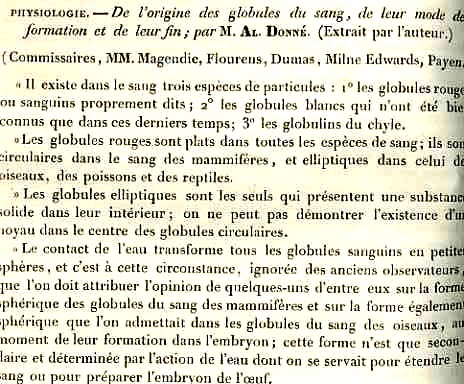JF Ptak Science Books LLC Post 547
Alfred Donne (1801-1878), physician, experimenter, microscopist and photographer, is best known for things other than what he should probably be best known for: his discovery of the third element of the blood, platelets. Donne had a wonderful vision, and was among the very first on the scene to write about and employ the spectacular invention of the daguerreotype in chemistry and microscopy. As a matter of fact Donne, along with his collaborator Leon Foucault, produced the very first engraved images of photomicrographs for his cytology paper of 1840. (He was also the first to use electricity in producing a medical illustration, and was among the first modern physicians to write on the great efficacy of mothers using their own milk in breast feeding their children.) The discovery of platelets paper of 1842*--preceding two other works published in the same year--does indeed identify the new object, but actually fails to make a methodological examination of the new body, calling the new units "globulins du chyle" (or small globules
derived from plasma). He also fails to make a drawing of what he saw; so, the combination of these two important elements asked the reader to accept his findings on faith, the tools of reproduction of his observations not being present. And so we remember Donne for some other significant things, na dless so for his lightly-interpreted and un-illustrated "dots".
*Donne, Alfred. De l'origine des globules du sang, de leur mode de formation et de leur fin. Comptes rendus de l'Académie des Sciences, Paris, 1842, 14: 366-168.
(Overall the history of the
discovery of platelets is convoluted:
Leewenhoek (1675) and Henson (1782) were the first to fully describe the “undefined”
particles of the blood; Donne’s work was then more fully described by Beale in
1850, and then again (identified as “small corpuscles” by Zimmerman in 1860 and
then again by Schultze in 1874 and Laptschinski (also in 1874). William Osler
then enters the scene in 1880, followed by Giulio Bizzozzero who was the
first, in the years 1881 -1882, to establish central role of platelets
not only in physiological haemostasis, but also in thrombosis. Anyway it is a longish and not-clear
history.)
.




I wonder if there are psychological dots, too? It would be some blip, something we're probably not even aware of. For men, it's probably sexual. Little dots peppering our inner life or our unconscious.
Posted by: Jeff | 14 March 2009 at 06:48 PM
I dunno, maybe the subconscious has altered the dots into holes of the unconscious. Or, to paraphrase James Jeans (or whomever), its probably dots all the way down...
Posted by: John Ptak | 15 March 2009 at 12:46 AM
I was thinking of our ego or emotional states as equivalent to waveforms, and so perhaps there is a particle equivalent in there. I don't have any further idea about it.
Posted by: Jeff | 15 March 2009 at 04:53 PM